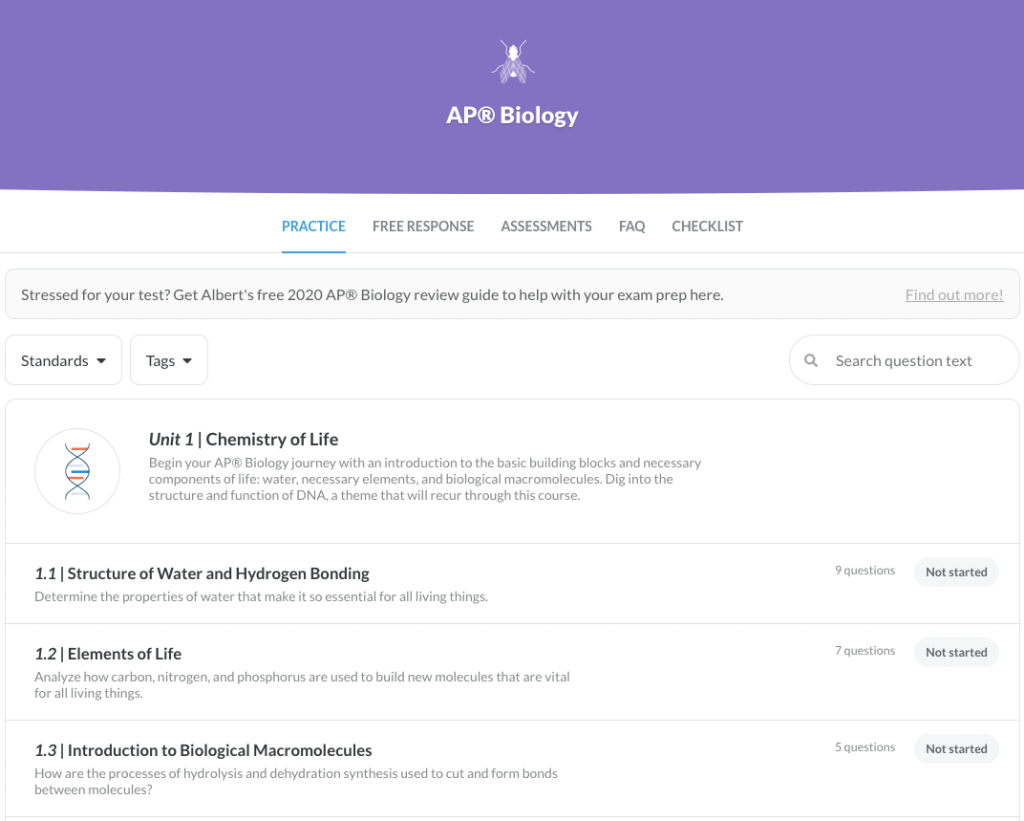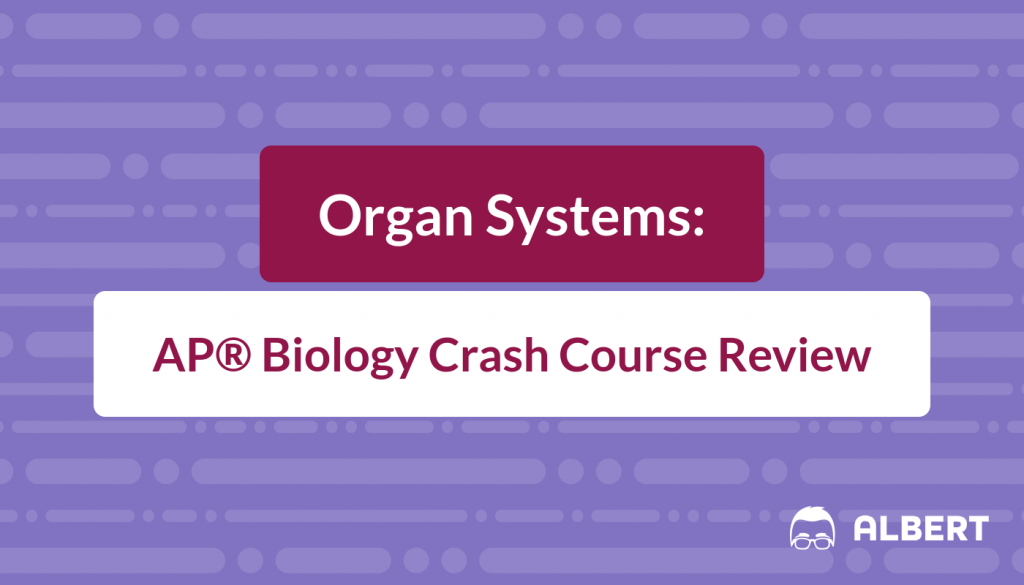Introduction to Organ Systems
Students often worry about the Organ Systems section of AP® Biology. There are so many organs in the body and so much information about each and every one. In this AP® Biology crash course review, we will go over the important information that you need to know for the AP® exam. We will highlight the nervous system, reproductive system, muscular system, skeletal system, circulatory system, respiratory system, immune system, excretory system, and digestive system.
Digestive System
The purpose of the digestive system is to break down food so that it can be used by the organism for energy. The digestive system begins with mechanical digestion. Mechanical digestion is physically done by the teeth chewing and breaking the food into smaller pieces. The larger starches will then be broken down into monomers of carbohydrates by amylase, a digestive enzyme found in saliva. Once the food is swallowed, the pharynx will receive the food. The pharynx will close the tracheal flap so that the food does not travel down the airway. Finally, the esophagus will receive the food and will use peristalsis (muscular contractions of the esophagus) to force the food to the rest of the digestive system.
Once the food reaches the stomach, it will be broken down further by enzymes and hydrochloric acid. The broken down food is then able to become absorbed into the body. The food that is not absorbed by the stomach will be moved to the small intestine which will use enzymes produced by the liver and pancreas to break down food. The large intestine will then process food that will be excreted as waste and will extract any water. Finally, the rectum will hold stool until it is released.
Excretory System
The excretory system functions to remove waste from the organism. This organ system removes the nitrogenous wastes produced by NH3. Humans excrete a form of nitrogen called urea (a major component of urine). The liver is the organ that is responsible for detoxifying the ammonia by creating urea. The liver will then send the urea to the kidneys which will be responsible for creating urine that will be excreted.
Circulatory System
The circulatory system consists of the heart and the blood vessels. The circulatory system is vital to the survival of the organism as it transports nutrients and removes waste all over the body. There are three main types of blood vessels: arteries, capillaries, and veins. Arteries carry blood from the heart; capillaries connect arteries to veins; veins return blood back to the heart.
Blood is transported in a very specific route because oxygenated blood cannot mix with deoxygenated blood. The blood is pumped through the right side of the heart where it is sent to the pulmonary artery. At the pulmonary artery, the blood is oxygenated and then pumped through to the left side of the heart and then on to the rest of the body through the main artery, the aorta. After the blood has distributed oxygen to the rest of the body, it will be sent back to the heart through the venous system.
Respiratory System
The respiratory system, as we have touched on above, is responsible for supplying blood with oxygen so that oxygen can be delivered to all of the cells in the body. The process of respiration involves the inhalation of oxygen and the exhalation of carbon dioxide. The major parts of this organ system are the lungs. The lungs are made up of tiny alveoli which are the place where gas is exchanged. Gas is exchanged from the alveoli to the red blood cells. Red blood cells contain hemoglobin and hemoglobin binds very effectively to oxygen. This binding will allow the red blood cells to transport oxygen all over the body. When the red blood cells get to an area that needs oxygen, the hemoglobin will release the oxygen allowing it to enter into the cells. The red blood cells will also pick up carbon dioxide to carry back to the lungs for exhalation.
Immune System
The main function of the immune system is to protect the body from foreign cells. This organ system is made up of a lot of working pieces. Bone marrow and the thymus create many of the cells responsible for destroying invading cells (viruses, fungi, bacteria). The spleen and the lymph nodes filter through blood and trap any foreign microorganisms. They then signal to the cells created by bone marrow and the thymus (T-cells, B-cells, NK cells) to come and destroy the invading cells. There are two types of immunity that an organism has: innate and acquired. The innate immunity is immunity that is nonspecific; this is immunity like skin or immune cells which will protect the organism from a host of antigens. The acquired immunity is the specific immunity that the organism has collected for itself due to previous infection.
Skeletal System
The skeletal system functions to support, protect, store minerals, and produce red blood cells. Bones in the human body fit together at the joints. The bones are surrounded by muscle which allows for movement to occur. The human skeletal system is considered an endoskeleton as it is found inside of the organism.
Muscular System
The major function of the muscular system is to allow movement and to help circulate blood throughout the body. There are three types of muscular tissue involved in this organ system that you should be familiar with: skeletal muscle, cardiac muscle and smooth muscle. Skeletal muscle is attached to the skeleton and is responsible for movement. Cardiac muscle is found in the heart, and it is involuntary muscle that pumps blood throughout the body in the circulatory system. Smooth muscle is the muscle found around many organs; it is also involuntary.
Muscle contraction involves a protein called myosin. Myosin moves across (the movement looks like walking) the filament using ATP and calcium. The contraction begins by the brain signaling movement, and it travels down the nerves. The nerves release acetylcholine which triggers the release of calcium and allows the muscle to move.
Nervous System
The function of the nervous system is to create coordination between the cells of the body. This organ system is divided into two major groups: the peripheral nervous system and the central nervous system. The central nervous system is made up of solely the brain and the spinal cord, and the peripheral nervous system is made up of all of the nerves that are found throughout the body.
The brain is made up of neurons which transfer a signal from the synapse to the dendrites. The dendrites release the signal, and the signal is taken up by a neighboring neuron which will then produce another signal at its dendrites. Neurons make up the brain and can be activated by a host of emotional, physical, and reflexive needs. Neurotransmitters are the chemicals which transmit the signals from one neuron to the next. There are several important neurotransmitters to know including: GABA, dopamine, histamine, etc.
Reproductive System
The function of the reproductive system is to continue the survival of the species via the production of offspring. In male organisms, sperm carries the genetic information. Sperm is created through the process of spermatogenesis which involves meiosis. Female organisms produce eggs through the process of oogenesis. Oogenesis is different from spermatogenesis because it produces a mature ovum (that can be fertilized) and polar bodies which will not be fertilized. Female organisms go through menstrual cycles. In humans, an egg is released every month. If the egg is not fertilized the female body will excrete the lining of the uterus and the egg. Every month the female will produce a new layer of the uterus and a new egg will be released from the ovaries.
Wrapping Up the Organ System & AP® Biology
This AP® Biology crash course covered the major organ systems. There are many more details that may appear on the AP® Biology exam, but this crash course has covered the basic knowledge you need for the exam.
Need help preparing for your AP® Biology exam?

Albert has hundreds of AP® Biology practice questions, free response, and full-length practice tests to try out.
Are you a teacher or administrator interested in boosting AP® Biology student outcomes?
Learn more about our school licenses here.

















